

Haffenden House / PARA. Architects Location Syracuse, NY, United States Architect in Charge Jon Lott Project Team Jon Lott, Hilary Pinnington, Paul Kneeply Area 1125.0 ft2 Project Year 2014 Photographs Manufacturers Buddy Rhodes, Buffalo Felt, Rochester Insulated Glass, Sepp Leaf From the architect.
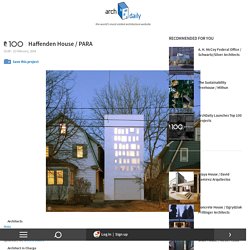
The Haffenden House is a writing studio with a garage/breezway at ground-level, library and writing space on the second level, and a curved/soft reading room on the third level. The project finds itself within the subur- buban realm, referencing Gianni Pettena’s Ice House from 1972, as a blank spot within the repetive image of “house.” In the rear yard, the fabric solution is used on the interior as a curtain, offering the owners the flexibility to control the relationship of privacy within their context. The poet’s studio uses a translucent silicon-impregnated fabric skin for a lightfilled writing room without the visual distraction of the suburbs. O House / Hideyuki Nakayama Architecture. O House / Hideyuki Nakayama Architecture Architects Location Kyoto, Kyoto Prefecture, Japan Architect in Charge Hideyuki Nakayama Area 59.71 sqm Project Year 2009 Photographs Takumi Ota , Courtesy of Hideyuki Nakayama Architecture Structural Engineers Mitsuda Structural Consultants General Contractor Shimizu-komuten Corporation Curtain Akane Moriyama Site Area 83.33m2 Built Area 42.9m2 More SpecsLess Specs From the architect.
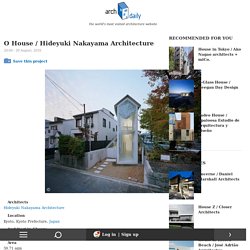
This house is located at the beautification zone of the ancient city of Kyoto, and it is built like two lean-to extended out from the 2-story main house. The center of activities is, if anything, based on those lean-to. Opera / Taka Shinomoto + Voar Design Haus. Architects Location Project Year 2015 Photographs From the architect.
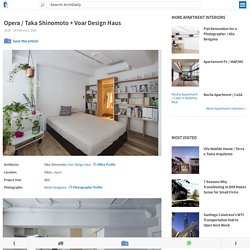
Taka Shinomoto and Voar Design Haus add layers of spaces within a Tokyo apartment. Typically finish materials are bound by the programmatic boundaries of a room, which makes a defined block of space. This could be compared to a brownie, it is a sweet treat that is the same all the way through. Taka Shinomoto and Voar Design Haus set out to make a space like an Opera cake: a sweet treat but with layers of different materials. House in Kashiwa / Yamazaki Kentaro Design Workshop. Architects Location Masuo, Kashiwa, Chiba, Japan Area 107.0 sqm Project Year 2014 Photographs Courtesy of Naoomi Kurozumi Architectural Photographic Office Structure Timber Major Interior and Exterior Structure Exterior galbarium interior plywood OSCL Structural Design ASD /Ryuji Tabata, Takayuki Tabata Site Area 182.69 sqm From the architect.
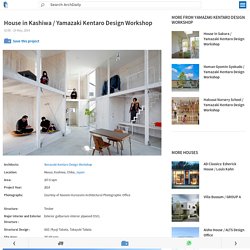
A “container” that changes as you design and live in it, and design it, on top of the challenge of living in such a house must continue to give you the pleasure of living there. Clothes, kitchen goods and other things related to their hobbies can be freely placed, and their living space can be filled with things that promote enjoyment and happiness in their lives. During the design stage, a new addition to their family arrived to add to the enjoyment of their home. Without defining or limiting the future possibilities of this family, we designed a house that allows for flexibility within their daily lives, such as hobbies and family. Mills House / Andrew Maynard Architects.
Architects Location Design Architect Project Architects Mark Austin, Natalie Miles Area 154.0 sqm Project Year 2015 Photographs Builder Grand Plan Properties Engineer Hive Engineering From the architect.
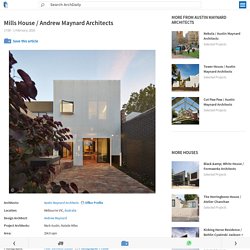
In a nutshell She’s a senior executive and now a new mum. For her and her newborn baby she wanted a light-filled home that could hide the mess. The what.Mills is an extension to a one level weatherboard terrace in Melbourne. Mills is a complex home, full of ideas, however there are 2 core elements.1. 50m2 House / OBBA. Architects Location Partners in Charge Sojung Lee, Sangjoon Kwak Area 50.0 sqm Project Year 2015 Photographs Design Team Jaeho Kim, Daae Kim, Hojae Lee, Sojae Ahn Construction TCM Global From the architect.
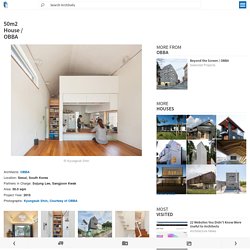
According to the Seoul Institute’s 2015 census data, the average floor area of a newlywed’s home is 72.7m2, and 44.6% of newlyweds live in an apartment building and/or multipurpose commercial/residential building typology. Two thirds of newly-wed couples lease on deposit basis, and 49.3% of those couples pay 100,000,000 to 200,000,000 KRW. The standardized typology and over-inflated housing price limit the parameter of choice in choosing a house for a young couple. The clients were soon to be married. The site is sitting in an entrance location of the Gaemimaeul, one of the few remaining colonies of rag pickers in Seoul, Seodaemoon-ku, Hongjaedong.
Batipin Flat / studioWOK. Architects: studioWOK Location: Milan, Italy Area: 28.0 sqm Project Year: 2015 Photographs: Federico Villa Design Team: Marcello Bondavalli, Nicola Brenna, Carlo Alberto Tagliabue Budget: 35.000€ From the architect.
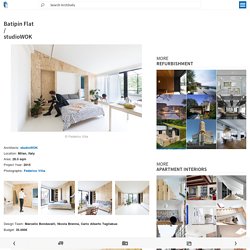
In this intervention the design challenge was to give to a small apartment of 28 sqm the living comfort of a bigger one. Minumum but livable service areas were designed to leave as much space as possible to the main room. The main space is simple and clean, a box labeled by the side walls paneled (batipin - plywood) and by a large window overlooking on the terrace to extend as much as possible the interior space to the outside. Spiral Window House / Alphaville. Architects: Alphaville Location: Osaka, Osaka Prefecture, Japan Structural Engineer : Takashi Manda (Takashi Manda Structural Design) Area: 28.95 sqm Project Year: 2013 Photographs: Kai Nakamura From the architect.
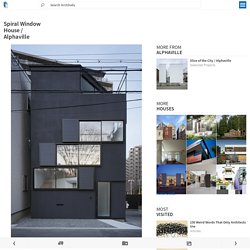
The narrow site is located at the heart of Osaka, surrounded by the back of some apartment houses. The client wants to have a view towards the Yodo River from the house, as well as having a rooftop terrace for enjoying the annual firework competition above Yodo River. Instead of simply putting openings on the direction to Yodo River, we displayed the small windows from the ground to second floor spirally, as if they were swirling.
Kame House / Kochi Architect's Studio. Architects: Kochi Architect's Studio Location: Niigata, Niigata Prefecture, Japan Architect in Charge: Kazuyasu Kochi Area: 135.0 sqm Project Year: 2013 Photographs: Takumi Ota Structural Engineer: Yukihiro Kato / MI+D architectural structure laboratory Site Area: 237.13m2 From the architect.
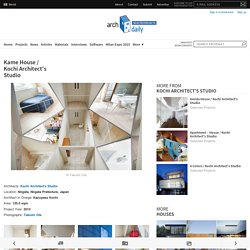
This house is located in new residential area in JAPAN. A House has 12 small rooms which has deferent function divided over two floors. House in Tama-plaza / Takushu ARAI Architects. Architects: Takushu ARAI Architects Location: Yokohama, Kanagawa Prefecture, Japan Area: 85.0 sqm Project Year: 2014 Photographs: Naomi Kurozumi From the architect.

Site around this house is in a residential area that follows the old, lined residential with a relatively large site. However, in recent years, by subsequent generations or land prices soaring, large grounds of the original is fragmented, and it began to replace the three-story house, so different housing group sizes and height it had mingled. House in Ishikiri / Tato Architects. Architects: Tato Architects Location: Osaka, Osaka Prefecture, Japan Architect In Charge: Yo shimada Garden Designer: Coca-z(Tatsuya kokaji) Structure Engineer: S3 Associates Inc. (Ichiro Hashimoto) Textile Designer: Akane Moriyama Area: 233.0 sqm Project Year: 2013 Photographs: Shinkenchiku Sha From the architect.
Dark concrete walls and a black archetypical house volume above it, a translucent lean-to roof, a white high flat roof and a silver box under it. Those totally different and inconsistent materials and colors are combined to form this house. Bagritsky / Ruetemple. Architects: Ruetemple Location: Moscow, Russia Architect In Charge: Alexander Kudimov, Daria Butahina Area: 80.0 sqm Project Year: 2015 Photographs: Ruetemple From the architect. The apartment is meant for a family with two children. Preferences of the customers and the main objectives. The customers would like to see a functional and laconic interior, yet not deprived of individuality and originality. House 12k / Dierendonck Blancke Architecten. House in Kashiwa / Yamazaki Kentaro Design Workshop. 3×10 House / DD concept. Focus sur les grands principes de la maison traditionnelle japonaise.
Kusatsu House / ALTS Design Office. Architects: ALTS Design Office Location: Shiga, Japan Architects In Charge: Sumiou Mizumoto, Yoshitaka Kuga Area: 116.0 sqm Year: 2014 Photographs: Yuta Yamada From the architect. We prepared this project for “Hatazaochi”, that means a lot whose figure is just like flag and the pole. This lot is surrounded by a condominium building and houses. There is a parking lot of a condominium building on the south side of the lot. Bricochic.com ARCHITECTURE JAPON. Case / Jun Igarashi Architects. House in Megurohoncho / TORAFU ARCHITECTS. Vertical Loft / Shift Architecture Urbanism. Ant-house / mA-style architects. House H by Sou Fujimoto. November 15th, 2009 House H is the latest project by Sou Fujimoto Architects in Tokyo.
It’s new experiment to find a balance between volumes, spaces and light. There’re a lot of stairs in this house and I’m also wondering where the bedrooms are. But I wouldn’t mind if Sou would do some projects in Berlin. Here are 2 other projects by Sou Fujimoto: House N and Next Generation House. House NA by Sou Fujimoto Architects. This Tokyo house by Japanese architect Sou Fujimoto has hardly any walls and looks like scaffolding (photos by Iwan Baan).
House NA has three storeys that are subdivided into many staggered platforms. The few walls that do exist are mostly glass, making certain spaces secure without adding privacy. See more projects by Sou Fujimoto here, including a stack of four house-shaped apartments. Share House LT Josai in Japan by Naruse Inokuma Architects. Japanese firm Naruse Inokuma Architects has designed a shared occupancy house in Nagoya with communal areas for eating, cooking and relaxing that encourage the residents to interact in different ways (+ slideshow). Naruse Inokuma Architects says the building was designed in response to the increasing demand in Japan for houses where unrelated individuals share kitchens, living spaces and bathrooms. Whereas most of these homes are adapted from existing properties, the architects based this new build on the principles of communal living and the need "for complete strangers to naturally continue to share spaces with one another.
" Bedrooms with identical dimensions are arranged across the building's three levels, with the voids between them housing an open plan living, dining and kitchen area and a rug space on the first floor. A dining table near the entrance provides seating for large groups, while the kitchen counter, sitting room and rug space offer alternatives for smaller gatherings.